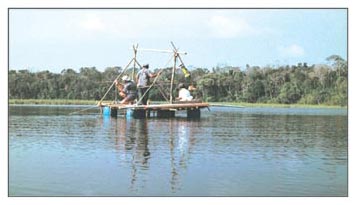| FAMSI © 2005: David Wahl |
||
Environmental Change and Prehistoric Agriculture in the Mirador Basin
Research Year: 2002 Table of Contents
Abstract Pollen, loss on ignition, magnetic susceptibility, and oxygen isotope analyses provide a high-resolution paleoenvironmental record from Lago Puerto Arturo, Petén, Guatemala. Chronologic control is based on eight AMS radiocarbon determinations. A long history of human activity in the Mirador Basin is indicated by 3600 years of watershed disturbance, from ~2700 B.C. to ~A.D. 900. This period coincides with a relatively dry climate in the southern Maya lowlands. Pollen shows an abrupt increase in anthropogenic disturbance in the Early Preclassic (~1450 B.C.), coincident with archaeological evidence of early settlement. The record indicates at least four phases of agricultural disturbance, with intervening periods of ecological recovery, during the following 2500 years. The last agricultural phase ended ~A.D. 900, coincident with the Late Classic abandonment of the southern Maya lowlands. There is no evidence for human activity in the region during the following 1000 years. Los análisis del polen, la pérdida por ignición, la susceptibilidad magnética, e isótopo de oxígeno proporcionan un registro paleo-medioambiental de alta resolución del lago Puerto Arturo, Petén, Guatemala. El control cronológico se basa en ocho determinaciones de radiocarbono AMS. Una historia larga de actividad humana en la Cuenca El Mirador se indica por 3600 años de disturbio en la cuenca, del ~2700 a.C. a ~900 d.C. Este período coincide con un clima relativamente seco en las Tierras Bajas Mayas. El polen muestra un aumento precipitado en disturbio antropogénico en el Preclásico Temprano (~1450 a.C.), coincidiendo con la evidencia arqueológica del establecimiento temprano. El registro indica por lo menos cuatro fases de disturbio agrícola, con períodos de intervención de recuperación ecológico durante los 2500 años siguientes. La última fase agrícola terminó ~900 d.C., coincidiendo con el abandono del Clásico Tardío de las Tierras Bajas Mayas. No hay evidencia de actividad humana en la región durante los 1000 años siguientes. Click to download the report in PDF format: Environmental Change and Prehistoric Agriculture in the Mirador Basin (60 KB) The PDF files require Adobe Acrobat Reader.
Submitted 08/19/2005 by: |
||
| Return to top of page | ||
|
Text links to all pages at this site are available at the FAMSI INDEX |
||
